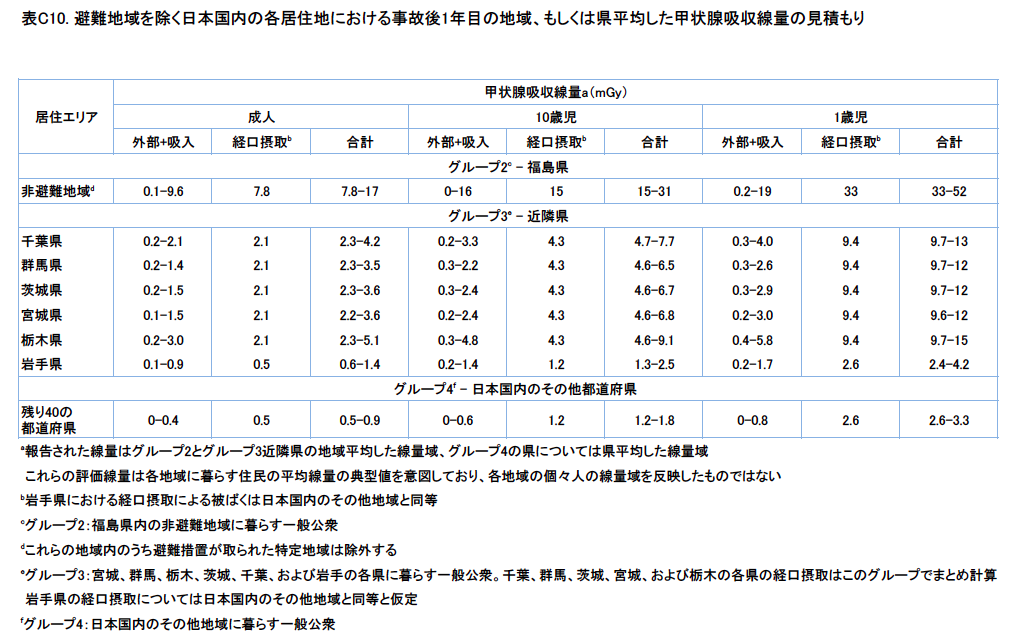原子放射線の影響に関する国連科学委員会(UNSCEAR)の2013年報告書(フクシマ報告書)が、2014年4月2日に公表された。日本国民の関心度の高さのためか、過去のUNSCEAR報告書とは異なり、今回のフクシマ報告書の公式日本語版は2014年4月末に公表予定だと記者会見時にアナウンスされた。
ここでは、付録E「作業員と公衆への健康影響」内の、「公衆の健康影響についての委員会のコメント」の中から、甲状腺癌に関連したいくつかのパラグラフを和訳した。
ちなみに、付録C「公衆被ばくの評価」は、study2007氏によって仮訳されている。また、2013年10月に国連に提出されたサマリー報告書の部分和訳はこちら、PSRとIPPNWによる注釈付き論評の和訳はこちらである。
UNSCEAR 2013 Report: "Sources, effects and risks of ionizing radiation"
ここでは、付録E「作業員と公衆への健康影響」内の、「公衆の健康影響についての委員会のコメント」の中から、甲状腺癌に関連したいくつかのパラグラフを和訳した。
ちなみに、付録C「公衆被ばくの評価」は、study2007氏によって仮訳されている。また、2013年10月に国連に提出されたサマリー報告書の部分和訳はこちら、PSRとIPPNWによる注釈付き論評の和訳はこちらである。
UNSCEAR 2013 Report: "Sources, effects and risks of ionizing radiation"
Volume I
Scientific Annex A:
Levels and effects of radiation exposure to the nuclear accident after the 2011 great east-Japan earthquake and tsunami
APPENDIX E. HEALTH IMPLICATIONS FOR THE PUBLIC AND WORKERS
II. HEALTH IMPLICATIONS OF RADIATION EXPOSURE OF THE PUBLIC RESULTING FROM THE FDNPS ACCIDENT
C. The Committee’s commentary on health implications for the public
1. Population of Japan and of Fukushima Prefecture
UNSCEAR 2013 報告書「電離放射線の線源、影響とリスク」
第1巻
科学的付属書A:東日本大震災と津波の後の原子力事故による放射線被ばくの程度と影響
付録E:公衆と作業員における健康影響
II. 福島第一原発事故の結果の放射線被ばくによる公衆における健康影響
C. 公衆の健康影響についての委員会のコメント
1. 日本の住民と福島県の住民
p.253(253ページ)
E29. Thyroid cancer. During the first year, incorporated radioiodine from the accident led to higher absorbed doses to the thyroid than to other organs and tissues. For adults in areas that were not evacuated, the district-average absorbed doses to the thyroid were less than 20 mGy in the first year after the accident (table C10). Available evidence indicates that the thyroid is not particularly sensitive to such doses during adulthood.
パラグラフE29
甲状腺癌。1年目には、事故により取り込まれた放射性ヨウ素が、他の臓器や組織によりも、甲状腺により高い吸収線量をもたらした。非避難区域の成人における事故後1年目の地域平均の甲状腺吸収線量は、20mGy以下だった。(表 C10)入手できる証拠によると、成人期の甲状腺は、そのくらいの線量には特に感受性が強くないことが示されている。
(注:表C10の和訳版は、study2007氏による付録Cの和訳より転載)
E30. In contrast, for 1-year-old infants who were evacuated after the accident, the Committee estimated settlement-average absorbed doses to the thyroid to be up to about 80 mGy (table C12). In the areas that were not evacuated, district-average doses to the thyroid were up to about 50 mGy (table C10). For example, the Committee estimated that about 35,000 children in the age range of 0−5 years lived in districts where the average absorbed dose to the thyroid was between 45 and 55 mGy.
パラグラフE30
その反面、事故後に避難した1歳児においては、委員会は、市町村平均の甲状腺吸収線量は最大で80 mGyであると推計した。(表 C12)非避難区域では、地域平均の甲状腺吸収線量は最大で50 mGyだった。(表 C10)例えば、委員会は、0−5歳の子ども約35,000人が、甲状腺の平均吸収線量が45−55 mGyである地域に居住していたと推計した。
(注:表C12の和訳版は、study2007氏による付録Cの和訳より転載)
パラグラフE31
委員会は、過去に、年齢が10歳での甲状腺吸収線量が200 mGyの場合の甲状腺癌リスクを評価した。甲状腺癌の生涯リスクは、被ばくにより大体2倍になったと推定された。しかし、仮に10,000人の子どもがそのような甲状腺線量に被ばくをしたとしても、リスク推定の不確かさは大きく、相対リスクは1.15から4.0の幅を持つ。WHOの放射線被ばくによる甲状腺癌のリスク推定は、もしもリスクの甲状腺被ばく線量への依存性が数百mGyからそれ以下の事故後の被ばく線量まで直線的であると仮定されるのであれば、委員会のものと一致していた。
E32. From an estimate of absorbed dose of 50 mGy to the thyroid of infants, and assuming that the risk of thyroid cancer could be extrapolated down to these dose ranges using a linear dose–response function, a relative lifetime risk of thyroid cancer due to the exposure over the baseline risk could be inferred to be about 1.3. Such an increase in principle ought to be discernible if the effect of increased detection rate due to sensitive screening and other factors could be isolated, although most of the increased incidence would be expected to appear several decades after the exposure. Furthermore, direct measurements of radioiodine content in the thyroid have suggested that actual doses to the thyroid for some individuals might be lower than the average doses estimated by the Committee using environmental measurements and modelling, although there are some questions about how representative the thyroid measurements generally were. A detailed re-evaluation of the absorbed doses to the thyroid taking into account all available information relevant to thyroid exposure including the thyroid measurements, their quality assurance and information on individual protective measures is highly desirable.
パラグラフE32
乳児の甲状腺吸収線量推計値の50 mGyから、甲状腺癌のリスクが直線線量反応関数を用いてその線量域まで推定可能であると仮定し、被ばくによる甲状腺癌の生涯相対リスクがベースラインリスクの約1.3倍であると推測できる。そのような増加は、原則としては、増加のほとんどが被ばくから数十年後まで現れないと予期されるにしても、感受性の高いスクリーニングによる検出率の増加や他の要因の影響を分離することができるのであれば識別可能であるべきである。さらに、甲状腺内の放射性ヨウ素の実測値は、その甲状腺測定値が一般的にどれほど代表的と言えるのかについての疑問がいくつかあるにしても、個人の甲状腺の実際の被ばく線量が、委員会が環境測定値とモデリングを用いて推計した平均被ばく線量よりも低い場合があるかもしれないことを示唆している。甲状腺実測値およびその精度保証と、個人の防護対策についての情報を含む、甲状腺被ばくに関して入手できる情報をすべて考慮した上での甲状腺吸収線量の詳細な再評価が非常に望ましい。
E33. The Committee estimated that the doses to the thyroid varied considerably among individuals, indicatively from about 2 to 3 times higher or lower than the average for a district. It considered that fewer than a thousand children might have received absorbed doses to the thyroid that exceeded 100 mGy and ranged up to about 150 mGy. The risk of thyroid cancer for this group could be expected to be increased. However, it would be difficult, if not impossible, to identify precisely those individuals with the highest exposure, and risks at these low doses have not been convincingly demonstrated; moreover, as noted above, the lower dose values suggested by direct thyroid measurements on some populations should be reviewed, as well as their associated uncertainties. Information on dose distribution and uncertainties was not sufficient for the Committee to draw firm conclusions as to whether any potential increased incidence of thyroid cancer would be discernible among those exposed to higher thyroid doses during infancy and childhood.
パラグラフE33
委員会は、甲状腺被ばく量が、直接法で地域平均よりも2−3倍高いか低いかと、個人によってかなり異なったと推定した。委員会は、1000人弱の子どもたちが、100 mGyを超え、約150 mGyまでの甲状腺吸収線量を被ばくしたかもしれないと認識した。このグループでの甲状腺癌のリスクは増えると予測できる。しかし、被ばく量が最大である個人を正確に同定することは、不可能でないにしても困難であり、これらの低線量でのリスクは、説得力を持って証明されていない。さらに、承前のように、甲状腺の実測値測定で示唆される、より低い線量の値が、それと関連した不確定さと共に再検討されるべきである。線量分布と不確定さは、乳児期と小児期の間により高い甲状腺被ばく量を受けた人たちの間で起こり得る甲状腺癌発生率増加が識別可能であるかについて、委員会が確実な結論を導くには不十分だった。






































